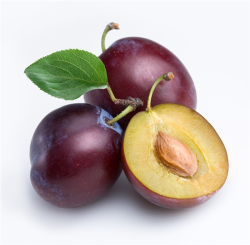Plum

The plum is an important symbol in parts of eastern Asia, where both the fruit and its flower carry significant meaning.
In Japanese culture, the plum is part of a group known as the “Three Friends of Winter”, which also includes the bamboo plant and the pine tree. Bamboo and pine are evergreen plants, and on plum trees the blossoms can sprout from branches that already look dead. Therefore, all three are representative of life and good fortune even during the colder/bleaker parts of the year. During the Japanese New Year, a popular decoration consists of a pickled plum (known as ‘umeboshi’) placed in the center of a square container of rice, mimicking the rising sun portrayed on the Japanese national flag.
The association of the plum with winter is also present in China. Confucianism, one of China's major philosophical systems, possesses a concept known as the “Four Gentlemen” or the “Four Noble Ones”, in which four specific plants (plum, orchid, bamboo and chrysanthemum) represent the seasons. Due to the plum blossom’s flowering in cold weather, it has come to symbolize winter in this context as well. During the period from 1912-1949, when the country was known as the Republic of China, the plum blossom also served as the national flower. Even today, the design of the Olympic flag of Chinese Taipei (i.e. Taiwan) is based on the plum blossom.
© Symbols.com
